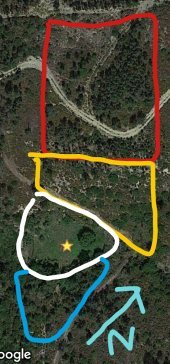








Idle dreamer
 4
4




 2
2




Tyler Ludens wrote:Will rain harvesting earthworks be built? If not, I would not expect the trees to survive, unless you get plenty of rain during the Summer. A permaculture food forest is part of a designed system based on rain harvesting. This is the case even in moist climates.












 2
2












 ) and won't be going back until September/October Im hoping it'll be alright left to it's own devices. Don't want to spend time fitting an overflow to the spring only to end up flooding the terrace with the Soaker hose anyway!
) and won't be going back until September/October Im hoping it'll be alright left to it's own devices. Don't want to spend time fitting an overflow to the spring only to end up flooding the terrace with the Soaker hose anyway! 















Cath Brown wrote:How exciting!
I'm also just about to put an offer on a piece of land (with spring) in central Portugal. I can't stop obsessing either!
I wish you all the best and look forward to more news on your journey.




 3
3




"The rule of no realm is mine. But all worthy things that are in peril as the world now stands, these are my care. And for my part, I shall not wholly fail in my task if anything that passes through this night can still grow fairer or bear fruit and flower again in days to come. For I too am a steward. Did you not know?" Gandolf












 1
1




 2
2




Yes, I'm that David The Good. My books are here: http://amzn.to/2kYcCKp. My daily site is here http://www.thesurvivalgardener.com and my awesome videos are here https://www.youtube.com/subscription_center?add_user=davidthegood
















 1
1









List of Bryant RedHawk's Epic Soil Series Threads We love visitors, that's why we live in a secluded cabin deep in the woods. "Buzzard's Roost (Asnikiye Heca) Farm." Promoting permaculture to save our planet.




David Good wrote:The mistake I made with my first big food forest project was to think fruit trees would do okay without a lot of input or soil improvement ahead of time.
Water is definitely the main thing you need and it's good you have it. Before I went nuts with fruit tree, I would first concentrate on planting a lot of nitrogen-fixers and chop-and-drop species to build up the land and increase the biomass on it. I wish I'd done that the first time around. After dropping loads of tree company mulch and planting lots of support species, most of my fruit trees pulled through and began to thrive - but for two years they basically sat. And I lived on site and did water and mulch them a bit. Just not enough.
Most fruit trees are highly bred over thousands of years to be food producers for man. They're not scrappy pioneer species that can be left to themselves.
Xisca - pics! Dry subtropical Mediterranean - My project
However loud I tell it, this is never a truth, only my experience...




Iterations are fine, we don't have to be perfect
My 2nd Location:Florida HardinessZone:10 AHS:10 GDD:8500 Rainfall:2in/mth winter, 8in/mth summer, Soil:Sand pH8 Flat

|
I am going down to the lab. Do NOT let anyone in. Not even this tiny ad:
The new kickstarter is now live!
https://www.kickstarter.com/projects/paulwheaton/garden-cards
|






